Research and Development
R&D is expensed
in the period in which the R&D activity occurs. The dollar returns
of R&D often materialize in years after the expense, virtually
insuring that accounting profit is lower than it otherwise would be in
any year in which R&D is undertaken.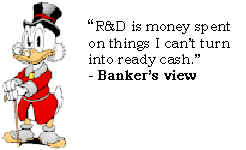
Expensing R&D is the product of accounting conservatism, reflecting the intangible nature of R&D and its lack of value as collateral to lenders.
Economics of R&D
For every dollar spent on R&D, the expectation is that at least a dollar of value is created. However, that value is usually realized in profits that can stretch years into the future.
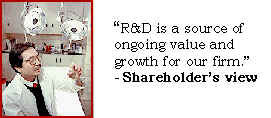
Profits arising from R&D can begin to appear soon after the expenditure, but often do not begin to appear until a year or more after the project is initiated.
Sometimes, the value is not expected to be driven by any future cash flow from the expenditure per se, but from real options created by the expenditure.
Regardless of the pattern of profitability expected for any particular R&D project, the market generally recognizes the promise of R&D long before those profits have fully materialized, particularly for companies with a strong record for value creating R&D.
Behavioral Impact
Expensing what should be viewed as an investment is a clear case of mis-matching costs and benefits in reporting. If management is experiencing a year of lower-than-expected profitability, one tempting target is to reduce expenditure in R&D. This is tempting precisely because the foregone benefits of R&D spending may not be felt for several years, while the benefits of the spending cut appear dollar for dollar in the current period.
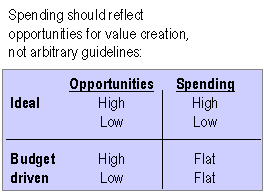

In many cases, R&D spending is budgeted as a percentage of sales. This tends to keep R&D relatively smooth over time. Opportunities, however, do not smoothly appear over time. Using a percentage-of-sales rule for R&D spending tends to encourage over or under-spending relative to true opportunities for value-creating investment that arise.
Alternative Treatments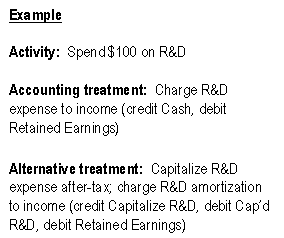
Capitalizing R&D: Since R&D can be viewed as an investment, it can be treated as one, that is, capitalized and amortized over the expected life of the benefits. R&D should be capitalized on an after-tax basis, including any benefits of investment tax credits.

Separating long-term from current benefits: Not every expenditure categorized as R&D might have long-term benefits. Some of the expense might be "maintenance" development with fairly current benefits (or penalties, if the expense is not incurred).
It may be necessary to segregate spending on certain projects or categories such that only those items with long-term benefits get capitalized.
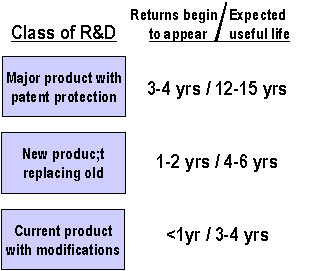 Stratifying different classes of R&D: Not all R&D projects with multiple-year benefits have the same
expected life. Some projects may be expected to add to profitability for
just a few years while other projects may have expected benefits
extending for a decade or more. For some project, returns may take a
while to materialize at all.
Stratifying different classes of R&D: Not all R&D projects with multiple-year benefits have the same
expected life. Some projects may be expected to add to profitability for
just a few years while other projects may have expected benefits
extending for a decade or more. For some project, returns may take a
while to materialize at all.
R&D projects should be segregate by class according to their expected useful life (including the period during which returns have not yet appeared). This will help determine the appropriate amortization period for these capitalized expenses (even if you do not end up assigning different amortization periods to different classes of R&D).
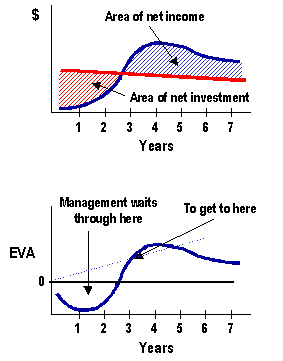 Lagging returns:
For certain projects, the first significant profits may be expected
to materialize more than a year after the investment. For such projects,
amortizing their costs in the year after expenditure can undermine
motivation to incur make the investment since the investment costs will
significantly precede the profits and lead to negative EP in the early
years.
Lagging returns:
For certain projects, the first significant profits may be expected
to materialize more than a year after the investment. For such projects,
amortizing their costs in the year after expenditure can undermine
motivation to incur make the investment since the investment costs will
significantly precede the profits and lead to negative EP in the early
years.
For such project, then, it is not enough to simply smooth the costs over time. We must suspend the onset of those costs using a strategic investment adjustment that matches the pattern of capital charges to the expected pattern of returns.
Full cost vs. successful efforts: Once an R&D project has begun and its expenses have been capitalized, the possibility exists that the project may fail to yield any benefits. Once a failure is recognized, conservativism would dictate writing off the unamortized balance of capitalized R&D. This is referred to as "successful efforts" accounting, meaning that only the successful efforts get fully amortized.
The behavioral impact of this approach depends on the ratio of "winners" to "losers" in the portfolio of R&D investments and their prospective payoffs.
For high risk portfolios, i.e., where the payoffs can be very high but the ratio of "winners" to "losers" is very low, successful efforts accounting exposes management to significant risk of apparent short-run failure that may promote under-investment in R&D.
In such circumstances, management should consider "full cost" accounting, whereby unsuccessful efforts continue to be amortized rather than written off. This is likely to encourage a more appropriate level of investment from the shareholders perspective and encourage management to recognize failures in a timely manner and quickly shut them down.